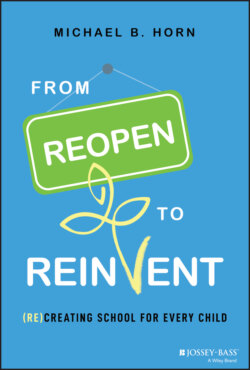Читать книгу From Reopen to Reinvent - Michael B. Horn - Страница 20
A BETTER WAY FORWARD
ОглавлениеToo often the debates around improving schooling get stuck in a zero-sum framing where for every winner there must be a loser. But the reality is that there are many more losers in our current education system than winners. By moving to a positive-sum system and a mindset of abundance rather than scarcity, we can transform that system into one that benefits both the Jeremys and the Julias of the world.
In that world, as children grow up, schools will help them discover and build their passions, understand what it takes to pursue what they want, learn how they can contribute value to society, and fulfill their human potential. Although many people are scared of change because of what they might lose, everyone has much to gain.
As schools have struggled over the past three academic years and the media has fretted about learning loss, education experts have recommended everything from summer school for all to redshirting every student. What these ideas share in common is that all students should just have more of the same type of schooling experience they've always had—a schooling experience that wasn't working.
In the years ahead, students will need personalization to meet them where they are—not just academically, but emotionally and socially as well. They will need support and help building strong relationships and networks. They will need to develop strong habits of success. We will need to think comprehensively and expansively, because if the goal is to help all students succeed in today's complex society, going back to the way things were is not an option.
That's what this book is designed to do. In the chapters ahead, we revisit many of the themes and ideas presented here in the Introduction. Unpacking them offers a way forward so that all members of society can benefit from a better, more enjoyable, and more positive schooling experience.
Chapter 1 explains how to reframe the predicament in which educators find themselves as an opportunity, not a threat.
Chapter 2 encourages educators to start with the end in mind—what's the purpose of schooling?
Once the goal is defined, it's easier to work backward to make sure students develop what they need to be successful. Chapter 3 walks through a theory to help schools define their proper scope so that they can successfully fulfill their purpose.
Against that backdrop, Chapter 4 describes what students are really trying to accomplish—and where traditional schools fall short. It asks all of us to move past the notion of learning loss.
Chapter 5 outlines what the student experience should look like to help students accomplish their priorities. It shows why we need a system that guarantees mastery for each student.
Chapter 6 reimagines the teaching experience with an emphasis on helping educators think about the “T” in teachers standing for “teams.”
Chapter 7 speaks to the parent experience and how to design schools and new solutions to fit into the progress that parents desire.
Chapter 8 talks about the technology imperative in today's world and offers some tips for choosing educational software.
Chapter 9 discusses the importance of the right culture and how to create it.
Chapter 10 helps educators create a mindset of testing, learning, and iterating. It proposes that rather than creating a “plan” and following it blindly, educators shift to thinking about “planning” as a verb—a perpetual cycle that allows people to learn and improve.
All of these changes described in the preceding chapters will be hard. Stakeholders will have varying levels of agreement. To bring the different strands together, Chapter 11 offers a framework to help leaders manage change when key stakeholders have varying views on the goals of schools or how to realize those outcomes.
With the havoc that COVID has caused and the challenges educators, students, and parents face, the appetite for new solutions that work for everyone will be larger than before.
* * *
To seize the moment, we will follow the fictional stories of Jeremy and Julia set in an elementary school in California at the beginning of each chapter.
